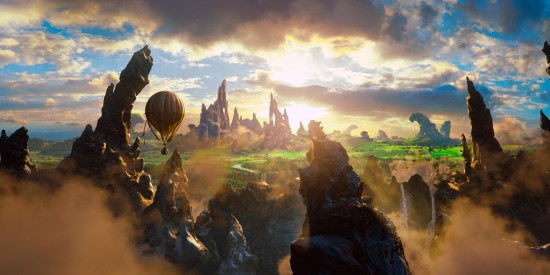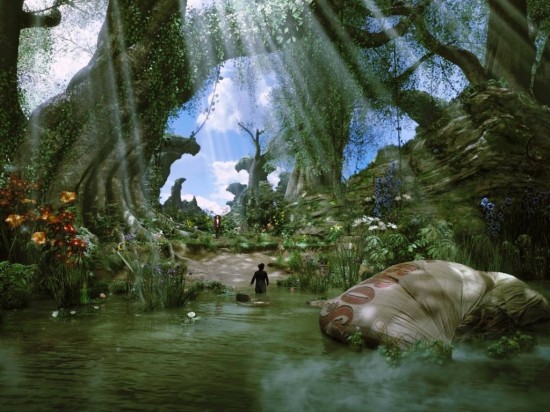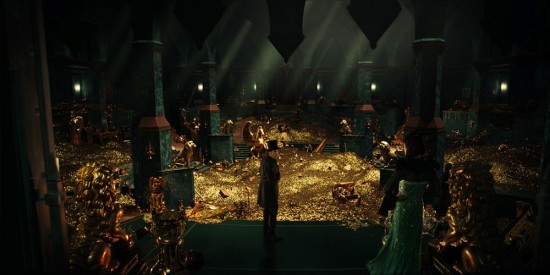35 Things We Learned On The Set Of Sam Raimi's 'Oz: The Great And Powerful'
In October 2011, I got to visit the wonderful world of Oz and watch director Sam Raimi direct his preboot (prequel/reboot) of the classic L. Frank Baum book series. I learned much on the set of Oz: The Great and Powerful. Most fascinating to me was some of the things Disney had to do satisfy legal concerns over possibly violating copyrighted imagery from the classic 1939 film adaptation, owned by Warner Bros.
And while trailers for the film focus on wholly computer-generated worlds and characters, you might be shocked to learn the lengths that Sam Raimi went through to shoot a lot of the film practically. For example, it was interesting to see Raimi inventing new practical solutions to help the supporting actors create and react to live performances for characters who would eventually be created in CG — and I'm not talking about performance capture.
After the jump you can watch a video blog we recorded talking about the visit, followed by many more things I learned while on the set.
Video Blog: Below is a video blog I recorded with Steve from Collider.Possible Spoiler Warning: Please be warned that the video blog features some brief mentions of which character/actress becomes the Wicked Witch. While people familiar with the original books/previous movie(s) should be able to guess pretty easily, the reveal in the film has been thus far been kept out of the marketing campaign. When we were on set, it wasn't treated like a secret or mystery, so we did talk freely about this plot point/character in the video we recorded following the visit.
You can use the chapter guide below the video to skip the discussion of the Wicked Witch (if you skip section 17:15-19:15 you will be fine). But please feel free to read the rest of this report without worrying about this possible spoiler.
Timecode:
35 Things We Learned On the Set of Sam Raimi's 'Oz The Great And Powerful'
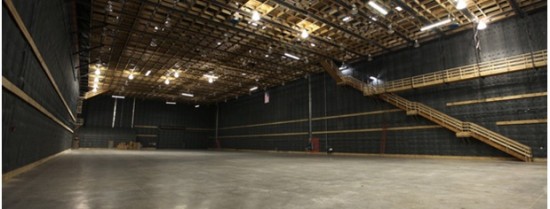 1. The Yellow Brick Road was rebuilt in the suburbs of Detroit.
1. The Yellow Brick Road was rebuilt in the suburbs of Detroit.
We visited the set at Raleigh Michigan Studios in Pontiac, Michigan on October 20th 2011, three months into the planned five month shoot. (Principal photography began on July 25th 2011). To give some perspective, Real Steel had just been released and Puss In Boots would be coming to theaters another week. Filming in Michigan is a homecoming of sorts for director Sam Raimi, who made many of his early films in the area.
Oz: The Great and Powerful is the first film to shoot in Raleigh Michigan Studios, which once was a General Motors trucking design plant. The studio houses 200,000 square feet of sound stages, with 3 sets revolving on each of the 8 stages. Three of the huge stages are next to each other, which allows Raimi to visit and give direction on second unit work in between takes with the first unit.
A few years ago Michigan passed very aggressive tax incentives that brought over 100 film productions to town; most recent at the time was the Dreamworks produced Real Steel. The Avengers and other films have since decided to film elsewhere, and Oz was one of the last films to qualify for these tax cuts before the state decided to eliminate the generous tax credit. The producer admits they would not be filming in Michigan without the tax incentives. The crew is roughly 600 people, 300 of which are local. The day I was on set there were also about 150 local extras. Raimi says the people here in Michigan really appreciate having a job, and that they are so talented and wonderful to work with.
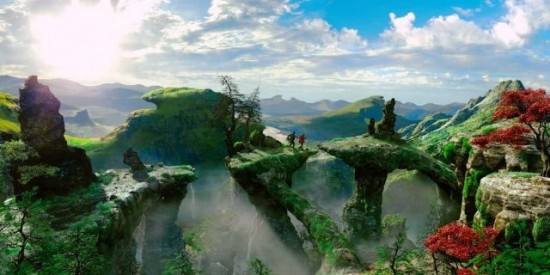 2. The world of OZ looks like a mash up of Avatar and Tim Burton's Alice in Wonderland, with a touch of Disney fairy tale magic and even inspiration from... Song of the South?
2. The world of OZ looks like a mash up of Avatar and Tim Burton's Alice in Wonderland, with a touch of Disney fairy tale magic and even inspiration from... Song of the South?
Visual Effects designer turned Production Designer Robert Stromberg has only two credits as production designer, but is batting 1000 — both films (Avatar and Alice in Wonderland) have earned him Academy Awards. Stromberg is known as a world builder, able to create fantastically detailed and expansive fictional environments. Oz is his third film as designer.
The saturated landscapes look like a mash up of Tim Burton's Alice in Wonderland and James Cameron's Avatar, a combination of real and surreal-looking elements. One concept rendering shows a lush green mountain which bridges above the yellow brick road which winding around and underneath. The interiors and exteriors of the castles look inspired by some of the animated Disney classics. For example, the interior of Glinda's castle features very elaborate wallpaper, reminiscent of the designs in the Haunted Mansion.
Stromberg admits that in addition to the original Wizard of Oz, he referenced other Disney films like Song of the South. The Emerald City is very art deco-influenced, all royal green with yellowish gold features.
He tried to create something that pays respect to the original film we've grown up with but also takes viewers to the next level of filmmaking and art direction. The Oz we will see in this film is supposedly something closer to the one described in the original books than the original Wizard of Oz movie.
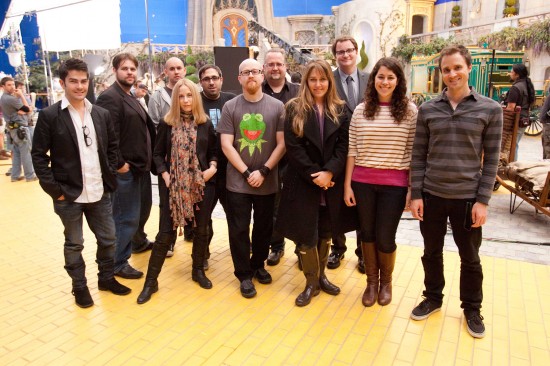 3. The surreal world of OZ was created practically with big sets and computer rendered set extensions.
3. The surreal world of OZ was created practically with big sets and computer rendered set extensions.
Sam Raimi insisted on using physical sets with blue screen backdrops instead of rendering the entire set with virtual environments, something that was considered early on. The entire film was shot on sound stages, and not one frame was shot outside. Raimi says that he couldn't even shoot a sky because none of the landscapes in OZ could ever fit in our reality.
Michelle Williams said she found it incredibly freeing that Sam gave the actors physical sets to live in, puppets to react to, and loved that he didn't leave them out in the cold to act against a blue screen.
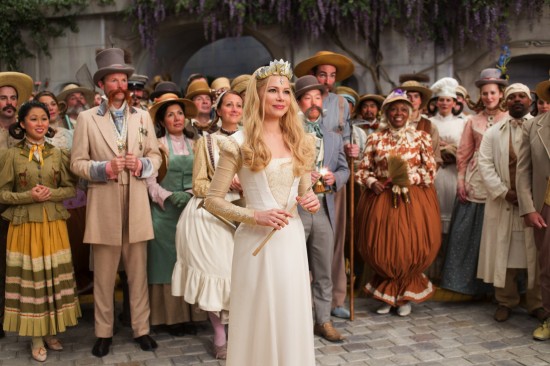 4. Oz: The Great and Powerful is a Rise of the Planet of the Apes-style prequel.
4. Oz: The Great and Powerful is a Rise of the Planet of the Apes-style prequel.
The screenplay, written by Mitchell Kapner and David Lindsay-Abaire, is based on characters, places and stories told throughout L. Frank Baum's series of 14 books set in the OZ universe. It imagines the origins of the man who becomes "The Wizard of Oz", and explains how the Wicked Witch came to be so wicked.
James Franco plays Oscar Diggs, a small time magician in a traveling circus who feels above his current situation. A hot air balloon ride into a storm (complete with, you guessed it, a tornado) transports him to the world of Oz. The world is in turmoil and it has long been prophesied that a Wizard would come to save the land. But which of the world's three witches can he trust — Theodora (Mila Kunis), her older sister Evanora (Rachel Weisz) or Glinda (Michelle Williams)? The answer may seem obvious to those who have watched the 1939 film, but the story is brilliantly structured with twists and turns you might not expect.
The last act of the movie is a huge battle and takeover of emerald city. We will learn how the Wizard becomes the man behind the curtain, complete with a projection on a large head. And through the course of the adventure, Oz will transform from a selfish man to a selfless man.
The goal of the story is to honor the original Wizard of Oz story but add to the mythology in a way that it might even enhance the reading of the earlier work. And as fans know, Baum's Oz book series offer many more stories on which to base a possible sequel.
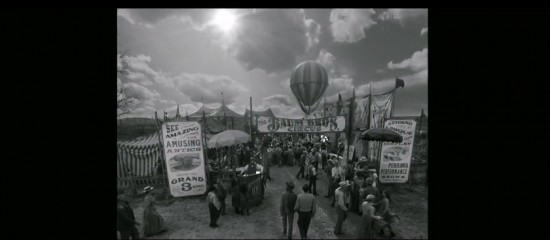 5. The Kansas-set opening is in black and white.
5. The Kansas-set opening is in black and white.
The opening sequence, set within a traveling circus stop in Kansas, was shot in the first two weeks of photography. It will be projected in black and white, and will be presented with mono sound and a smaller aspect ratio. The 3D depth will be dialed down, but still present. This is an obvious homage to the 1939 film which transitions from black and white to technicolor.
The aspect ratio grows when Frank arrives in Oz. That's shown in a 30-second pullback shot that reveals Frank is no longer in Kansas any longer. Instead, his hot air balloon is floating above the wonderful land of Oz.
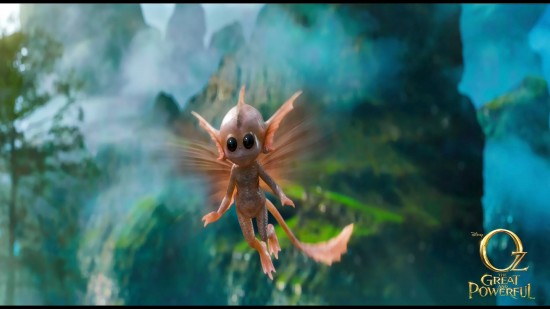 6. There are many different creatures in the land of Oz, some we know, many we've never seen before.
6. There are many different creatures in the land of Oz, some we know, many we've never seen before.
Many little creatures inhabit the world, including flocks of hummingbird/fish characters, and a small flying insect that looks like a mash up of an elephant and a butterfly. The Winkies are a group of 7-foot-tall soldiers that act as the Witches right hand henchmen.
The prequel features two types of flying monkeys, an angry baboon looking creature and a monkey that looks more like a cute chimpanzee. Zach Braff voices Finley, one of the chimpanzee-like flying monkeys, Theodora's assistant, with whom Oz doesn't hit it off in the beginning.
One of the characters along for this adventure is a tiny 18 inch tall breakable girl made of porcelain named China Girl (voiced by Ramona and Beezus star Joey King). Joey described the character as very sassy, having some attitude, but is also very sweet. Oz becomes kind of an adopted father to China Girl after he comes across her in China Town.
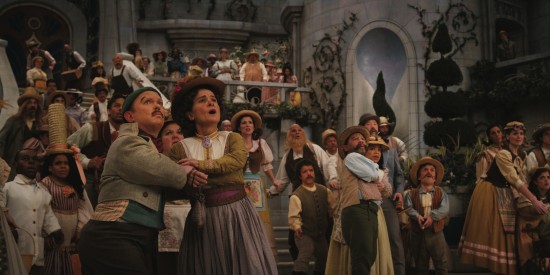 7. The film offers a more politically correct take on the iconic Munchkins.
7. The film offers a more politically correct take on the iconic Munchkins.
35-40 little people were cast in the film to play Munchkins in this film. This time around they have spent time trying not to paint the Munchkins as odd. The characters are no longer wearing silly outfits. This film treats all of them as equals, basing their appearances off of their occupations.
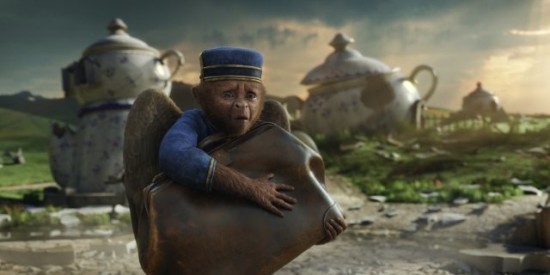 8. Computer animated characters were performed with live puppets and live voice recording.
8. Computer animated characters were performed with live puppets and live voice recording.
Sam Raimi didn't want to use performance capture to create the computer animated characters in this film. His alternative lets the voice actors be part of the performance process and gives the live action actors something to play off of.
For any scenes featuring these characters, Zach and Joey first perform the scene on camera with the live action characters to get a sense of the placement. Zach and Joey then preform the voices live in a soundproof booth in a trailer off to the side of the sound stage. The footage they record in the booth will be used by the animators for reference. Zach Braff compares the booth to being in a cockpit, acting to no one.
On stage, a pole is held out where the characters eye-line should exist. At the end of the pole is a monitor showing Zach or Joey's performance from the booth, along with a camera which captures POV footage which allows Zach and Joey to react to the live action actors in real time.
They also have a marionette on stage for reference for China Girl. While the marionette puppet won't ever be seen in the final film, it will give the animators something to base China Girl's movements on, and provides the live action actors something, perspective wise, to play off of.
Phillip Huber is the puppeteer that operates the 18 inch tall China Girl marionette. He is a famous puppeteer in the stage world, but known in the film industry for his extensive work on Spike Jonze's Being John Malkovich. Huber Builds all of his own marionettes, and built the China Girl puppet used in the produce based on the designs created by KNB. The puppet has 21 strings, has full head movement and animated eyes. It takes on average 300 man hours to build a puppet. At 10 hours a day, working five days a week, that is almost two months to create a single marionette. He produced two China Girl puppets for the film. Huber wears a blue leotard while operating China Girl on set, and has an ear piece which a feed of Joey's performance and a direct line to Sam for direction.
The day we were on set, Zach Braff was called to come in on his day off because Sam wanted his computer animated character to be in one of the shots doing something in the background. And since Sam is so very collaborative, he asked Zach to come in to discuss where in the frame is character should be and what he would be doing.
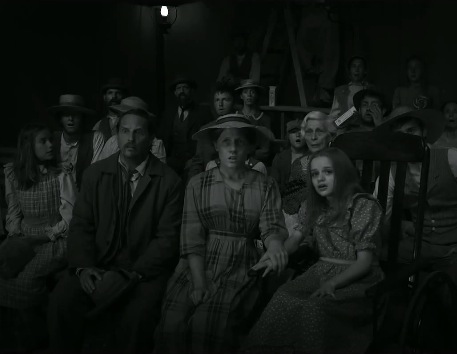 9. Many of the actors play duel roles.
9. Many of the actors play duel roles.
The Wizard of Oz featured some of the key actors in duel roles, playing counterparts in Kansas and in the land of Oz. This prequel also features actors playing multiple roles.
* Zach Braff who voices a flying monkey named Finley in Oz also plays Frank, Oz's magician's assistant at the circus who is treated very poorly.
* King plays a girl in a wheel chair at Oz's magic show who asks Oz "for something he can not give her." In Oz, King voices China Girl.
* Michelle Williams not only plays Glinda the good witch of Oz, but also Oz's childhood sweetheart in the real world. In the story she is getting married and she gives Oz the opportunity to stop it, which he doesn't take. Oz has never been able to commit to her, believing he is in for bigger and better things. Glinda is a reflection of this character/relationship.
* One of the concept renderings we saw featured a shot of them floating in bubbles through an epic landscape of Oz featuring an Elephant spaced mountain and plants that look like giraffes, references to the animals from Oz's life in the traveling circus.
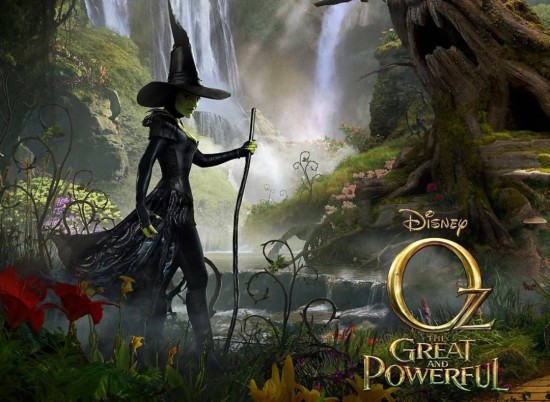 10. Legalities prevent some of the elements from the 1939 film from being used in this prequel story.
10. Legalities prevent some of the elements from the 1939 film from being used in this prequel story.
While the information, characters and descriptions in the original source material (L. Frank Baum's books) is free for adaptation, judges have ruled that Warner Bros owns the rights to the characters and depictions from the original Wizard of Oz film.
Disney was not able to use the ruby slippers, as they are owned by Warner Bros. The slippers were originally silver in the books but were given a bright color to play with the technicolor innovation for the 1939 film adaptation.
They almost didn't get to make the Wicked Witch a green color due to legalities, but fx makeup designer Berger was finally able to come up with a shade of green which satisfied Disney's legal team. It was far enough away from the green shade of the Witch from the original Wizard of Oz film to somehow qualify as an original take. The green is called theostein, because the color is close to the color of the original Frankenstein monster. One thing they were not able to get around was the signature mole on the chin, an iconic piece of the first Wizard of Oz film adaptation.
Sam Raimi didnt want to reimagine Certain elements like the yellow brick road and Emerald City. Raimi says that he wanted to tell a different story on the yellow brick road and in Emerald City, using the comparison that he didnt want to tell a new story set in a reimagined New York City, he wanted to tell a new story set in NYC. However the legal issues required them to make changes to even those elements. In the end, they should feel tonally the same.
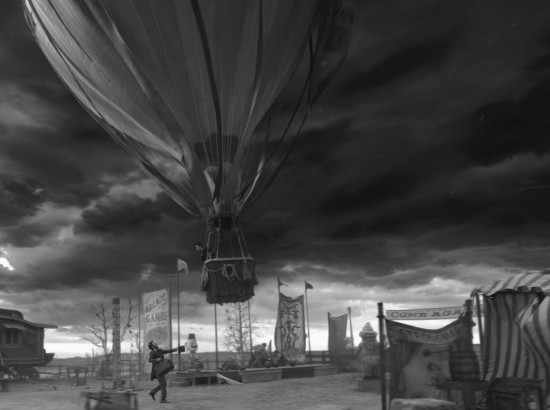 11. The film features a few winks and nods to the Wizard of Oz.
11. The film features a few winks and nods to the Wizard of Oz.
It is harder to pay too much respect/homage to the original film, as in many cases, they aren't legally allowed to. But there are Hidden references to the original Oz in the story.
While the scarecrow, lion or tin man do not appear in the movie, Stromberg has tried to include those characters in various aspects of the design. For example Oz builds a fake army made up of scarecrows for the final battle in the film. Lions are part of the motif, and featured on the throne and flags in Emerald City (they appear in he style of the illustrations from the book.)
There is a callback to the red sand in the hour glass from the original film. Weisz character uses the magic red sand to produce a music box out of thin air.
The movie was shot natively in 3D on the Red Epic. Almost everyone pushed to shoot it in stereo rather than to post convert the footage afterwards. They will take the time to step back and show expansive shots of the whole world which will open the depth of the world. Sam monitors the filming on regular 2D monitors as he found trouble focusing while switching his view from the 2d Zach/Joey booth cam and the 3d camera monitor. They do have a 3d monitor on set to view the footage in 3d.
They also have a monitor where they are able to render what the 3d rendered backgrounds and set extensions will look like composited into the shot. They use this rough rendering to frame shots and also during editing of the film, until the design can be fully rendered and composited into the final edit.
While the classic Wizard of Oz film was a musical, this prequel features only one musical aspect — something that features the Munchkins, but different from what we've seen prior.
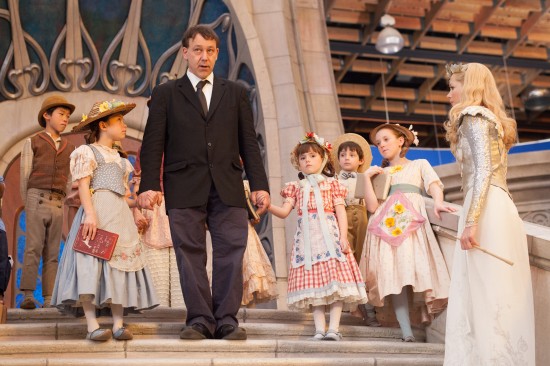 15. As with any Sam Raimi production, the movie features a number of cameos from the usual Raimi players.
15. As with any Sam Raimi production, the movie features a number of cameos from the usual Raimi players.
The original three witches from the Evil Dead movies were given cameos, as was Bruce Campbell (who you will meet somewhere in Oz), Sam's brother Ted Raimi (who appears in the Kansas opening sequence), John Paxton (who played the butler in the Spider-man movies), and more.
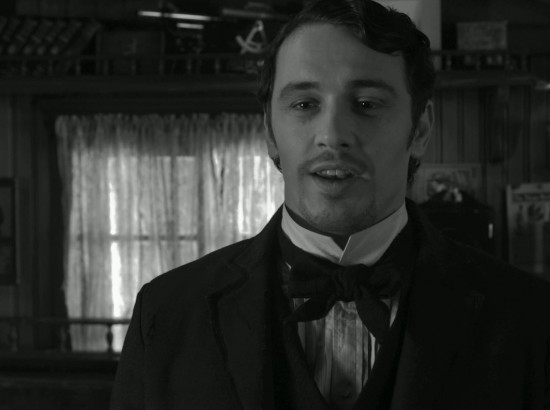 16. Robert Downey Jr almost played The Wizard.
16. Robert Downey Jr almost played The Wizard.
Robert Downey Jr was originally set to play Oz, and when he dropped out Johnny Depp considered the role for a brief time before James Franco came on board. During our interview, Franco relayed a story that Sam had told him about how Raimi gave Downey Jr. a small little plant during their first meeting. When Sam returned to Downey's house for a second meeting weeks later, he noticed the plant was already dead in the corner — a metaphors for the actor's involvement in the project.
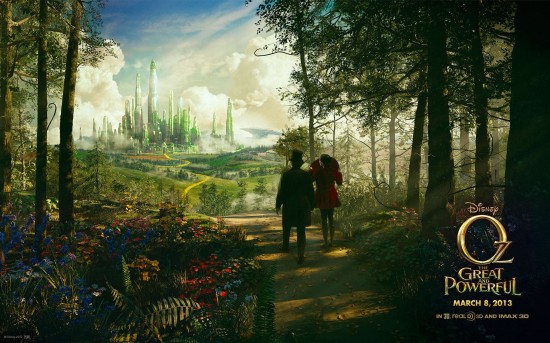 17. The yellow brick road takes on the environment it's in.
17. The yellow brick road takes on the environment it's in.
In the Dark Forrest, rocks, leaves and dirt cover the edges of the yellow brick road. The road is dinged, darker, disrupted by roots, warped and buckled on small hilly ground – definitely seen better days. .
In the Emerald City, the road is perfect and shiny. In China Town, the road is much thinner to match the scale of the miniature buildings.
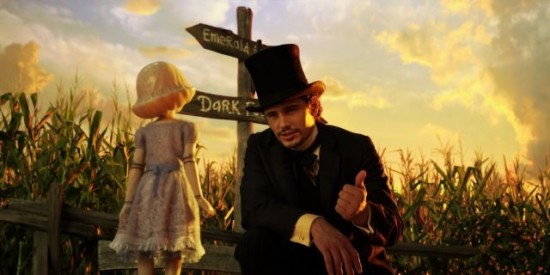 18. China Girl lives in a land called China Town.
18. China Girl lives in a land called China Town.
The buildings have teapots for roofs. The environment looks like a new land you might find at Disneyland. Pieces of the China Girl's house are cracked off like cracked dinner wear. New Deal constructed the buildings in Los Angeles and they have been flown to Detroit and reassembled on this stage. China Girl is the sole survivor of the destruction by the evil raids sent by the wicked witch.
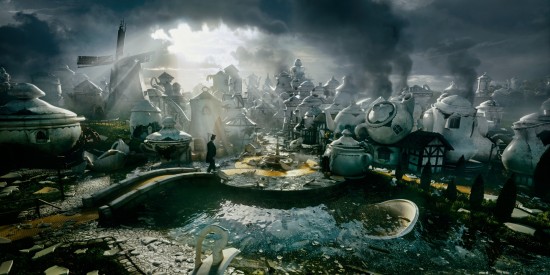 19. Oz Could Become Part of Disneyland
19. Oz Could Become Part of Disneyland
Disney Imagineers visited the Oz set, and were particularly taken with a concept image of a hot air balloon flying into Oz for the first time. They are exploring opportunities for a ride/attraction or maybe even a land in the Disney theme parks if the movie does well.
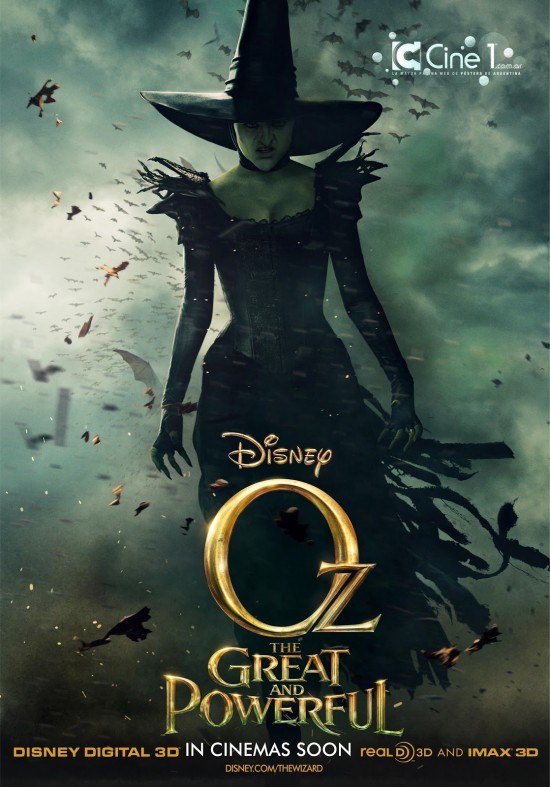 20. KNB Effects Is doing the special effects make-up on the film.
20. KNB Effects Is doing the special effects make-up on the film.
KNB started working with Sam Raimi in 1986 with Evil Dead 2, and has worked with the director throughout his career, including on his last film, Drag Me To Hell. KNB was picked for their comfort with and artistry in prosthetics work. KNB co-owner Howard Berger knew he wanted to be a special effects artist since he was 8 years old. The Wizard of Oz is his father's favorite film, and it was that film and Planet of the Apes that inspired him to do this for a living.
By the end of the shoot, KNB will have applied makup on almost 4,000 Munchkins.
The Wicked Witch make-up takes one and a half to two hours to apply and covers the actress' entire face except for her upper lip. The makeup is comprised of a forehead and nose section, a horseshoe bottom piece, and evil hand gloves. When Berger was first designing what she would look like, he kept it simple, believing that the studio would want the star's face visible under neath the appliances. When he presented his concepts to Sam and the actress, both agreed to go much further.
30 makeup artists are working on the production, including some of the all-time greats, like Kenny Diaz who worked on Carpenter's The Thing and is the guy who has been doing Ronald McDonald's makeup for almost 40 years.
The makeup artists have to arrive at 2am to begin working for a 6am crew call time. None of the makeup appliances are ever reused. Each day is a new application and at the end of the day the noses are thrown away. So they need to create tons of silicon and foam appliances, every day they receive shipments of boxes from LA.
Berger used to do the makeup for Robert Englund in the Nightmare on Elm Street movies. Englund quickly learned to rip a piece of his makeup off right after they called wrap every day, which would mean he couldn't be pulled in for another take, shot or second unit. Berger told [the actress playing the Wicked Witch] this story and she has adopted the practice of asking her fellow cast members (like Franco) or crew members to rip a piece of her makeup off after they call wrap.
KNB Effects held a Halloween party for the production. The invitations taped around the production office use an image of the hat box ghost from Disneyland's Haunted Mansion.
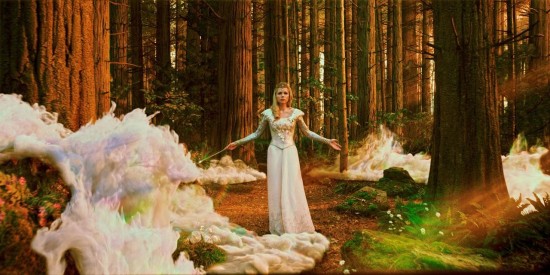 21. One of the big innovations on this film is a light set-up that simulates the sun.
21. One of the big innovations on this film is a light set-up that simulates the sun.
One of the big innovations on this production is a 168 pars, 180k-watt light set-up that simulates the sun. It is the biggest single light that's ever been made. Created specifically for this production, and never done before. The light allows them to light a huge 200ft set with a single source, something that wasn't achievable in the past. The amount of heat that comes from the light is so incredible that they need to turn it off in between takes. The lights in the array are completely modular and can be expanded if needed.
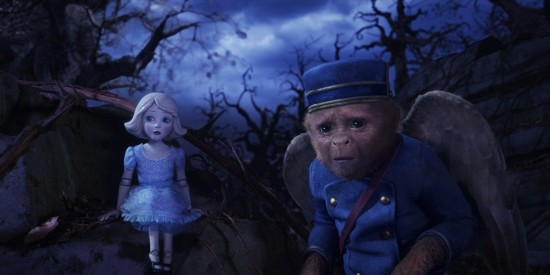 22. Being on a set with a youngster can cost a lot of money.
22. Being on a set with a youngster can cost a lot of money.
Joey King goes around set with a potty jar, a piggy bank she named Dirty Word Diana. When adults cast and crew members swear around her, they must pay. She says that Casey, the first AD, "has a down payment, so he's good for a while." She is also required to have three hours of school a day while she works. Her elaborately decorated class room is located down the hall from the soundstages.
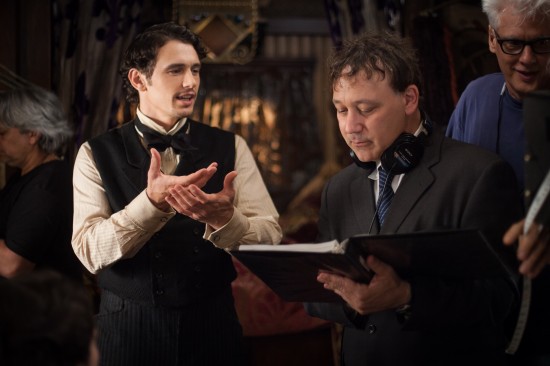 23. Sam Raimi Has Only Read a Few of the Oz Books.
23. Sam Raimi Has Only Read a Few of the Oz Books.
Sam Raimi had only read four of the books. He was always afraid to read the books because he loved The Wizard of Oz and didn't want to ruin it. After working on the development of this film he explored a few more of the book series and has enjoyed them.
When Raimi read the script, he realized it was a love poem to the original film, and he didn't know it at the time, but Baum's books too. He says it's a very American story, about people rising up for freedom, and an ordinary man using only his ingenuity to dear the powerful evil witch warlords and save the world. But he also thinks its a more universal story than an American story.

